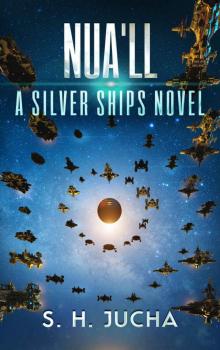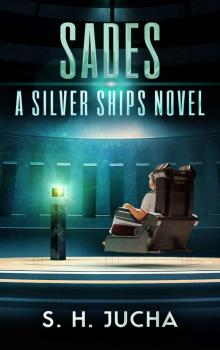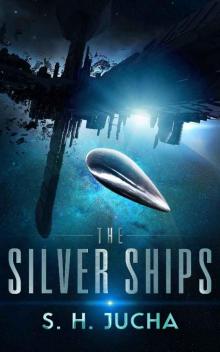- Home
- S. H. Jucha
Haraken (The Silver Ships Book 4) Page 7
Haraken (The Silver Ships Book 4) Read online
Page 7
* * *
A millennium ago, Earth launched colony ships in a highly publicized effort to focus the public’s attention on humankind’s expansion to the stars and away from Earth’s dire environmental circumstances. Climate change was wreaking havoc around the globe. Greenland’s glaciers were melting, as were most of the Arctic’s and Antarctic’s ice. Coastal cities were flooding, and lowland countries, such as India, were losing huge swaths of land to the ocean.
The Resource Wars, as they were called, started in the Middle East. Oil-rich, desert countries sold their primary asset, not for credits, but for shipments of water, food, technology, and contracts for water desalination plants and pipelines. Large, wealthy countries found themselves embroiled in internal conflicts. In the United States, individual states sought to preserve their water supplies, impeding the flow of their rivers to neighboring states. The southwestern states battled one another in court and when that failed, the state governors sent their National Guard troops across borders to claim their water rights.
The US Army found itself playing peacekeeper to the states while the federal government expended huge sums of credits to build canals and pipelines to distribute shrinking water resources. Worst of all, the food production of America’s breadbasket, which so much of the world depended on, was being limited to the North American US partners. Drought, which occasioned the land, became its constant partner, and crop production dropped to less than 60 percent of its former bounty.
Countries plagued with concentrated city populations and insufficient food production targeted other countries with abundant farmland, seeking to lock up exclusive trade deals, which inevitably fell apart. Food became scarcer, which drove prices up, until basic food commodities approached luxury status. By this time, trade deals were considered passé, because they were broken before the digital signatures were affixed. After that, it became a question of who had the power to take what they needed. Initially, nations banded together for trade leverage. Later, they left those organizations to fend for themselves, each nation having its own unique problems. When trade agreements and negotiations for resources failed, they banded together again — this time for protection.
In the midst of this slow, geopolitical demise, fusion reaction was discovered. Unfortunately, due to the fractious conditions, countries didn’t have the funds or intentions to implement the new energy source to reverse the environmental damage caused by centuries of industrial and human pollution. But the powerful and efficient fusion engines drove new, larger ships capable of carrying hundreds of passengers and freight between Earth and the planets and moons of Sol, the system’s star.
The outer planets’ habitats, originally established by nation states and multinational blocs, struggled to remain viable until fusion engines enabled the delivery of incredible numbers of people and massive material loads, leading to the transformation of small habitats into full-fledged colonies, most of which burrowed into the depths of rocky moons or built huge space stations. The new drives and ever-larger ships presented the opportunity for corporations, the wealthy, and the skilled to flee Earth’s troubles to the outer colonies. Nearly eighty-five million people left Earth during a period of four centuries.
In the end, the Final Wars, as they were titled, of the twenty-sixth century devastated Earth’s super-powers and small countries alike. United Earth rose from the ashes of the conflicts. It began as a grassroots movement, with a vigilantism mentality, and later became the basis of a strong, centralized, world government. The movement abandoned the government’s leaders and laws, national and local, in an effort to save the people — the sick, the starving, and the dying — the multitudes of the war-ravaged countries.
The desperate times created an unprecedented growth in crime at all levels of society. Governments, multinational corporations, small businesses, and people tried to do whatever they could to secure their safety. It was against the crime levels that the grassroots movement began, and it started in small towns and villages. People formed groups to provide protection for the local citizens, and they dealt with lawlessness ruthlessly. For the most part, the lesser offenders were run out of town. The more egregious offenders were summarily executed. Over time, the movement linked villages and towns, forming united fronts. As territory was reclaimed, the movement leaders clamored for a centralized organization, which grew until links formed across the oceans, creating the United Earth.
It would be a long, hard struggle before the movement’s name of United Earth could be actualized. What allowed the movement to grow quickly was the dissolution of almost every other government entity, as politicians at all levels fled their offices and sought safety for their families. The UE kept the draconian attitudes of the grassroots movement, enacting laws to combat the criminals: war profiteers, arms dealers, illegal drug manufacturers/distributors, murderers, slave traders, thieves, and every other manner of felon. Unable to afford incarceration systems, in its early years, the judicial process was quick and simple. A judge, not a jury, reviewed the evidence and pronounced the accused either innocent or guilty. The guilty were handed one of two sentences: a lifetime of servitude to the UE spent laboring in resurrected factories, farms, or public works projects or a swift and efficient execution.
The well-intentioned grassroots movement was slowly transformed into a totalitarian regime, enforcing its will around the globe. In its defense, the UE saved the human species from extinction, at least on Earth, at the expense of individual freedom. There became only one way for a person to live on Earth, the UE way, with no exceptions. Slowly, but surely, the one-third of the globe’s population that survived the Final Wars began to rebuild the world: food and water were shared, desalination plants were built by the hundreds, and only energy processes achieving a zero-carbon footprint were tolerated. It took more than three centuries, but one day, new ice formed on the barren Arctic lands.
Once the UE resurrected Earth’s economy and the environment, it turned to the remainder of the solar system. Colonies, dominated by the old multinationals, existed in domes and underground enclaves on Sol’s planets and moons. Extensive trade among the colonies fostered the building of enormous orbital stations to manage the freight and passenger vessels loading and unloading. During the turbulent centuries, Earth and the colonies continued to need one another and remained trading partners, although limited at times. As the colonies watched Earth succumb to its conflicts, they ramped up food production, water reclamation, and arms production in an effort to foster self-reliance.
United Earth bided its time, continuing to trade with the distant enclaves, while it rebuilt its space Navy, which was decimated during the Final Wars. When Earth’s forces were ready, the colonies were entreated to join the UE. The smaller colonies accepted the offer; the larger and more distant colonies refused. Unfortunately, for the latter group, the UE forces severely outnumbered any colony’s military forces, naval or militia, and the end result was a foregone conclusion. Once the UE held sway over the enclaves and stations, it applied its laws harshly and without exception, convinced that the human conditions that fomented the Final Wars stemmed from society’s excesses. Moderation and denial were the UE watchwords.
After the pacification of the system, the UE focused on expanding the colonies, using their growth to drive Earth’s industries. UE expansion was halted at the farthest asteroid belt due to the limitation of fusion drives. It was during this period that the long-lost computer records of Earth’s launch of the colony ships were discovered. These histories detailed the star destinations of each of five massive colony ships, but plans to contact these distant cousins were shelved until the UE possessed the capabilities of interstellar travel.
Centuries later the mystery of FTL flight was solved, and the concept of exploring the stars revitalized the UE plan to search out its distant cousins. The twin explorer ships, Destiny and Reunion, were built and launched within one month of each other toward the destinations of the first colony ships. It was hop
ed that they would discover readymade societies that could be folded into the UE. The Reunion’s mandate was to follow the path of the European-Indian Enclave colony ship to the planet coded as GL-137, which orbited a G-type, white star, called Mane — now the home world of the Méridien Confederation.
Destiny’s target was the star Cepheus, the destination of the North American Confederation colony ship, New Terra. Ironically, just weeks before the Reunion reached its objective, the Destiny was no more. It suffered the same fate as the New Terra, a millennium ago, when it plowed through an enormous swath of space rocks and dust. Unlike the massive colony ship, which was crippled by the encounter, the much smaller craft was obliterated.
* * *
Wombo settled comfortably onto a couch in Captain Lumley’s cabin while two crew members served them lunch. The captain took pity on Wombo after the first time the administrator visited with him in his quarters. The table’s narrow chairs were bereft of comfort for Wombo’s bulk, necessitating a short meeting, and certainly weren’t considered for an extended luncheon.
As soon as the crew left, the two men turned from idle chatter to a serious discussion. While they were indeed close friends, the isolation afforded them by a lunch meeting in the captain’s cabin was their opportunity to discuss business without other ears overhearing them. The cabin was the one place the men were confident was clear of droppers, at least none of the listening devices were ever discovered, and the captain personally swept his quarters twice daily.
“It’s been reported to me that Shin was again with Barbas last night, Olawale,” Lumley said.
“I’ve received the same report,” Wombo replied. “Do not worry, Captain, I’m being careful. I’m quite aware of Speaker García’s reputation, and I know his attack dog, the major, would love to apply some discipline to a wayward administrator.”
The two men ate in companionable silence for a moment before Wombo stated what had been on his mind. “You know, Captain, this is a sad state of affairs. We have discovered this incredibly advanced civilization, and we are acting like petulant children. We didn’t even bother to knock politely at the door. We just barged in and expected these people to welcome us into their homes.”
“They have been extremely tolerant of our presence,” the captain replied. “There is the possibility that they are a peaceful society and don’t possess a military as we define it.”
“If that were to be the case, I hope the speaker and the major never discover that,” Wombo said.
“You must keep your opinions close, my friend,” Lumley replied. “I worry that your views might become known.”
“One might wish to be part of such a world as this one,” Wombo said, contemplating his entrée dish. “I grow tired of the secrecy and the watching and the backstabbing.”
Lumley laid a hand on his friend’s huge shoulder. “Be patient, Olawale, who knows what the future might bring? Now, the chef has been especially generous to us today. Eat and enjoy.”
-9-
The Rêveur and the Last Stand exited FTL hours out from the Méridien system. Captain Manet brought the carrier to a delta-V of zero relative to the outermost planet’s orbit, while the Rêveur continued on into the system.
Alex, Renée, Tatia, Julien, and the crew were on the liner’s bridge when the access way doors swung open. Captain José Cordova strutted onto the bridge with an intoxicating woman on his arm. Her voluptuous body was encased in a red gown, slit on one side up to her upper thigh. Her figure, neither Méridien nor New Terran, was something between, and she swayed gently as she walked, managing to convey grace and temptation.
“Sers, I have the pleasure of introducing Miranda Leyton,” Captain Cordova said, lifting Miranda’s hand from his arm and guiding her forward toward Alex. The old captain’s eyes glowed with mirth.
Miranda stepped forward and delivered an old-fashioned curtsy to Alex. “It’s my great pleasure to meet you, Ser President. I have learned so much about you from Z.” Her polite introduction was in contrast to the effect of her low-cut gown, giving Alex an eyeful of her full breasts.
“I do hope the Earthers find my presence acceptable,” Miranda said to the group, twirling slowly, the slit gown revealing a shapely leg. She spent the next few moments entrancing the entire group. The more they heard, the more they were pulled into the entity who was Miranda.
“I like her,” Tatia declared.
“Why, thank you, darling,” Miranda purred. “I like you too.”
Julien replied.
Alex quickly shared this information with the others and instructed them to ensure this persona was addressed as Miranda. When Alex closed his comm, he found Miranda had stopped entertaining the bridge personnel and was watching him expectantly. It occurred to him that he needed to fully adopt Z’s plan and respond to Miranda. Who would have thought Christie’s romantic vids could be so helpful? Alex thought. He stepped forward and held out his hand to Miranda, who placed her hand gently in his. Alex bowed over it and brushed a kiss across her fingers. “It’s a pleasure to have you with us, Miranda. I’m sure the Earthers will find you as charming as we do.”
That Miranda could blush slightly and at the same time ever so slightly turn and twist her hips and shoulders to attract the eye amazed Alex. “You are ever so gallant, Ser President,” Miranda gushed, “I do so hope you’re right.”
Renée held a hand over her mouth to keep her own slack-jawed expression private. When Z first approached her with questions about females a half-year ago, she found his conversations entertaining. She shared her New Terran vids with him and even scoured the planet for more, finding a huge treasure of the vids with Christie. Z never revealed his final plans to her, and the headshot he showed earlier hadn’t been enough to identify Z’s creation. He had imitated the appearance and mannerisms of a well-known New Terran actress, known for her roles as a romantic lead and often as a femme fatale.
“If you will excuse me, Ser President,” Miranda said graciously,” I have an urgent appointment waiting for me in my cabin. A young man by the name of Z requests my presence.”
Alex found himself hypnotized by the sway of the red gown as Miranda left the bridge. He felt Renée’s hand slip around his upper arm and heard her giggle.
“Incredible, is it not?” Renée remarked.
Alex noticed that everyone was intently watching Miranda exit the bridge. The gleam in Captain Cordova’s eyes made his face look a hundred years younger.
“Incredible,” Alex agreed.
“Why do I have the feeling I should be asking Z for lessons on feminine wiles?” Tatia asked, breaking the group into bouts of laughter.
* * *
The Rêveur unobtrusively slid into the Méridien system, joining the flow of inbound ships and heading for a passenger orbital station.
Julien and Z were able to gather detailed telemetry as the UE winged ship crossed their path once during the days of sub-light transit. They updated Alex, Tatia, and Captain Cordova on the bridge with their new findings. Z was housed in his Exchange director’s persona of Helmut, a green-eyed, blond-haired, common Méridien genetic style.
“Mr. President,” Julien began, “we concur with much of Esther’s original conjectures that the bays of the Earther ship house fighters and the ports conceal missile tubes. In addition, we have identified two long tubes tucked next to the ship’s fuselage. Our best hypothesis,” Julien said, nodding toward Z, “is that these tubes might be projectile launchers.”
“How would these rail guns be employed?” Tatia asked.
“According to New Terra’s colony records, Admiral, rail guns were used in tandem with a fleet of ships to set up a defensive shield against enemy vessels,” Julien replied. “On an individual ship, they would only have advantage against a fixed target.”
“An orbital station or a planet,” Tatia concluded.
“Precisely, Admiral,” Julien replied.
“Any other consideration for the tubes?” Alex asked.
“A lesser possibility, Ser President,” Z replied, “is that the tubes conceal high-intensity lasers. This was given a significantly lesser probability due to the amount of energy required to make the lasers effective armament. The design of the craft is quite slender. It does not exhibit any large volume areas necessary to contain the storage mechanisms that would contain the energy required to fire the lasers frequently.”
“Fighters, missiles, and rail guns,” Alex mused.
“Hardly a recipe for a diplomatic mission,” Captain Cordova added.
“Reminds me of a Terran Security Force investigator’s command during an arrest,” Tatia said. “You can come quietly or you can come draped on a stretcher.”
* * *
Alex, Renée, Tatia, and Julien sat in the owner’s cabin discussing the contact strategy for the Earthers. Alex’s suggestion of a personal call between him and the speaker was greeted by Renée’s snicker and Tatia’s rolling eyes.
“I take it there are alternate suggestions,” Alex grumbled.
“By alternate, do you mean better?” Renée asked innocently.
Before Alex could respond, Tatia jumped in, “You had an ingenious idea at New Terra, Alex.”
“Yes,” Renée said excitedly, “the chat with Christie, which was broadcast to the population, Alex.”

 Nua'll
Nua'll Artifice
Artifice Sades
Sades Conclave
Conclave Q-Gates
Q-Gates Talus
Talus Jatouche (Pyreans Book 3)
Jatouche (Pyreans Book 3) Conclave (The Silver Ships Book 20)
Conclave (The Silver Ships Book 20) Alliance
Alliance Elvians (The Silver Ships Book 18)
Elvians (The Silver Ships Book 18) Earthers
Earthers Veklocks
Veklocks Sol (The Silver Ships Book 5)
Sol (The Silver Ships Book 5) The Silver Ships
The Silver Ships Sojourn
Sojourn Haraken (The Silver Ships Book 4)
Haraken (The Silver Ships Book 4) Messinants (Pyreans Book 2)
Messinants (Pyreans Book 2) Allora (The Silver Ships Book 7)
Allora (The Silver Ships Book 7) Messinants
Messinants Omnia (The Silver Ships Book 9)
Omnia (The Silver Ships Book 9) Libre, A Silver Ships Novel (The Silver Ships Book 2)
Libre, A Silver Ships Novel (The Silver Ships Book 2) Méridien (The Silver Ships Book 3)
Méridien (The Silver Ships Book 3) Vinium (The Silver Ships Book 10)
Vinium (The Silver Ships Book 10) Celus-5 (The Silver Ships Book 8)
Celus-5 (The Silver Ships Book 8) Empaths (Pyreans Book 1)
Empaths (Pyreans Book 1)